Care & Services
CARING FOR YOUR CARBON BLADES
It’s very important to wash and hand-dry your carbon steel blade thoroughly after each use. Carbon tends to react with acid, so it’s good practice to wipe the blade with a towel in between foods. As the steel is exposed to different elements, it will begin to naturally oxidize, or patina. Over time, this patina will act as a protective layer against rust.
REMOVING RUST, WATER STAINS, OR UNWANTED PATINA
- First, you can take a used 3M™ scrubbing sponge (a new one would be too abrasive) with a little bit of detergent and rub lengthwise. Do not let the detergent sit on the blade for extended periods of time.
- If that doesn’t work, take the same used sponge and use a powdered scrubbing compound like Bon Ami® or Comet®
- If that still doesn’t work, use a NEW 3M™ scrubbing sponge with a cleaning compound.
- Beyond that, you will need to use sandpaper to remove the corrosion.
How to polish your knife at home
You will need WD-40, a variety of wet sandpaper, a wood block with a flat edge lined with a softer material like leather or foam, and a raised surface.
TIP: First start with a higher grit of sandpaper (1200 grit) and move to a lower grit if it’s not removing patina or corrosion.
Step 1
Apply a small quantity of WD-40 on the blade. Wrap a low grit of sandpaper around the rubbing block, use your pointer finger to secure the paper.
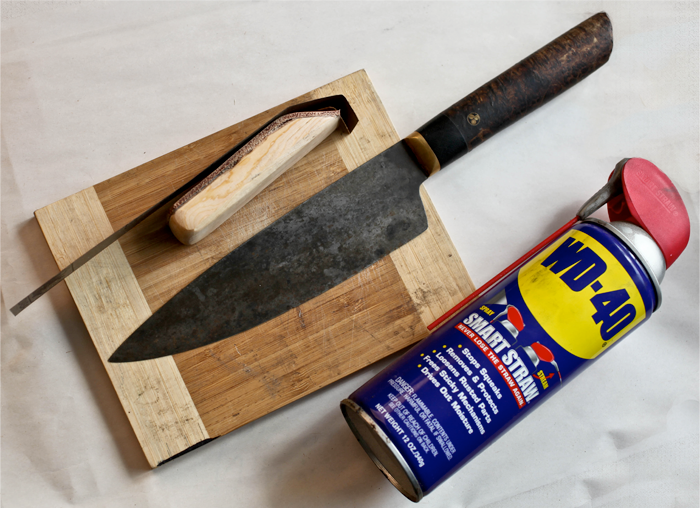
Step 3
Repeat the same process, wiping the blade periodically to check your progress. Rinse and hand-dry when finished.
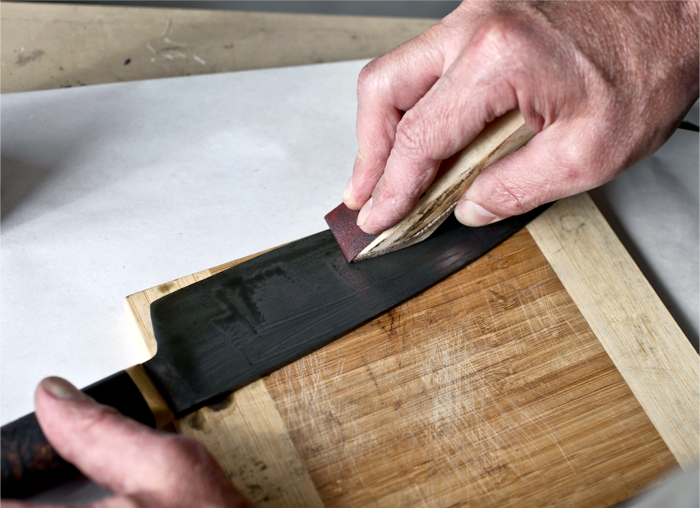
Step 2
Slowly rub lengthwise, using control and medium pressure. Once you’ve removed rust, water stains, or unwanted patina, move to a higher grit of sandpaper to polish the blade.
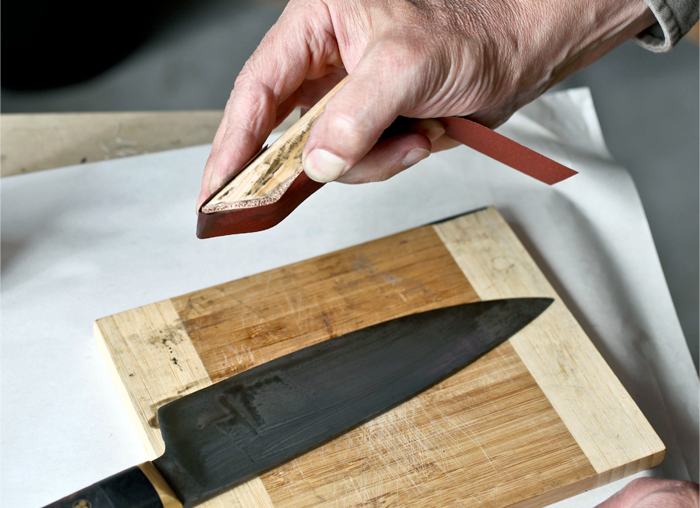
Step 4
For a matte finish, end with a 600 or 800 grit. If you would like a mirror finish, keep sanding up to 2500+
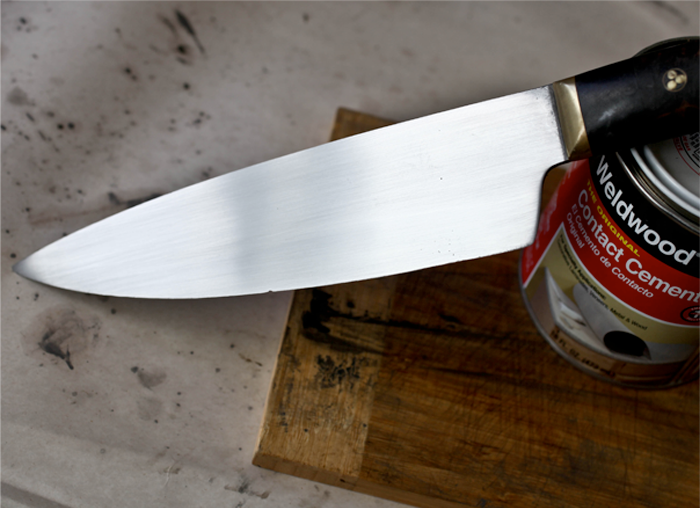
Forcing a Patina
KEEP IN MIND:
Unlike stainless, carbon is organic and reactive. The temperature or food, the type of food, and the vinegar that comes in contact with your knife will all affect the natural and forced patina. The process described below may not work the same in every situation.
Bob doesn’t like to force a patina to keep the color even. He just cleans and dries his carbon knives and lets the patina develop naturally. Bob finds the slightly uneven color aesthetically appealing.
SUPPLIES: VINEGAR (ANY KIND) AND A PAPER TOWEL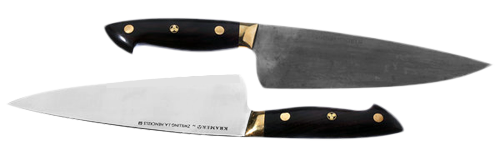 Step 1 – With the paper towel, rub the vinegar evenly across the blade on each side.
Step 1 – With the paper towel, rub the vinegar evenly across the blade on each side.
Step 2 – Let the vinegar sit for about 4 minutes.
Step 3 – Rinse off the vinegar and hand-dry thoroughly.
Step 4 – Reapply as many times as needed to generate an even-ish color.
PLEASE NOTE:
Do not let the vinegar dry on the knife. Rinse it off after a few minutes. If your blade already has a patina in some areas, those areas will be ‘farther along’ in the oxidation reaction and the color will be darker.
WOOD HANDLES
To keep your wood handle in good shape for many years and prevent dryness or cracking, Bob recommends a polymerized linseed oil like Tried and True Danish Oil. It’s a food-safe oil that will harden. You can also use Tung Oil or Danish Wood Oil. Apply a small quantity with a paper towel, and let it soak into the wood for 20 minutes before wiping off the excess. Allow to dry completely before storing.
WASHING & STORAGE
Gently wash with soap and thoroughly dry your knife after each use. DO NOT PUT YOUR KNIFE IN THE DISHWASHER, it will damage the blade and cause the handle to crack. After washing, keep your knife in a universal block, on a magnetic bar, or in a plastic edge guard.
MAINTENANCE
Routine maintenance is essential for a high-efficiency knife. Sharpening is simple, fun and the knowledge is free. Read our sharpening page for techniques and step-by-step videos.
Our Services
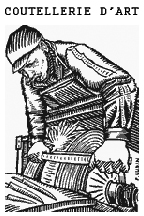 Over twenty years ago Bob opened a small business sharpening knives, which eventually led him into the fantastic world of Bladesmithing. Today, he’s decided to stop sharpening non-custom knives— as much as he would like to offer this service, he no longer has enough time.
Over twenty years ago Bob opened a small business sharpening knives, which eventually led him into the fantastic world of Bladesmithing. Today, he’s decided to stop sharpening non-custom knives— as much as he would like to offer this service, he no longer has enough time.
“I want to thank my supportive client base for participating in my pursuit of understanding culinary knives.” -Bob Kramer
Owners of Kramer Custom Knives
Bob Kramer offers sharpening & reconditioning services exclusively for owners of Custom Kramer Knives. Bob charges $375 per hour for reconditioning. Please Contact us before shipping a knife.
Owners of Kramer House Production Knives
Kramer Knives does NOT offer sharpening & reconditioning services for owners of Kramer House Production Knives made by Shun or ZWILLING.
Professional Sharpeners
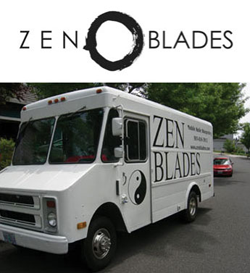
ZEN BLADES MOBILE KNIFE SHARPENING, Portland OR
Woody Bailey is located in the Portland area and worked with Bob to learn power sharpening. He is also a teacher at Oregon Culinary Institute. Visit Zen Blades website or call (503) 816-3913.557
HIDA TOOL & HARDWARE, Berkeley CA
Sharpening Drop offs are only accepted on Monday, pickup on Wednesday. Check out their great selection of Japanese woodworking and gardening tools and knives. You won’t find any power tools, although they do stock a large assortment of drill bits for your hand or powered drills. Visit HIDA TOOL’s website.
KORIN KNIFE SHARPENING, New York NY
Korin is the first company in the world that was given authorization and certification to re-sharpen and repair knives from Masamoto Shohonten, Misono, Knife Systems (Suisin), and Nenohi. Korin accepts drop-offs or mail-in requests. Visit Korin’s website.
DISTRICT CUTLERY, Washington DC
Mail in or drop off any knife to be sharpened by certified experts. DC offers additional services including blade restoration, blade repair and thinning, Takeda repair, and Fujiwara regrinding. Visit District Cutlery’s website.
